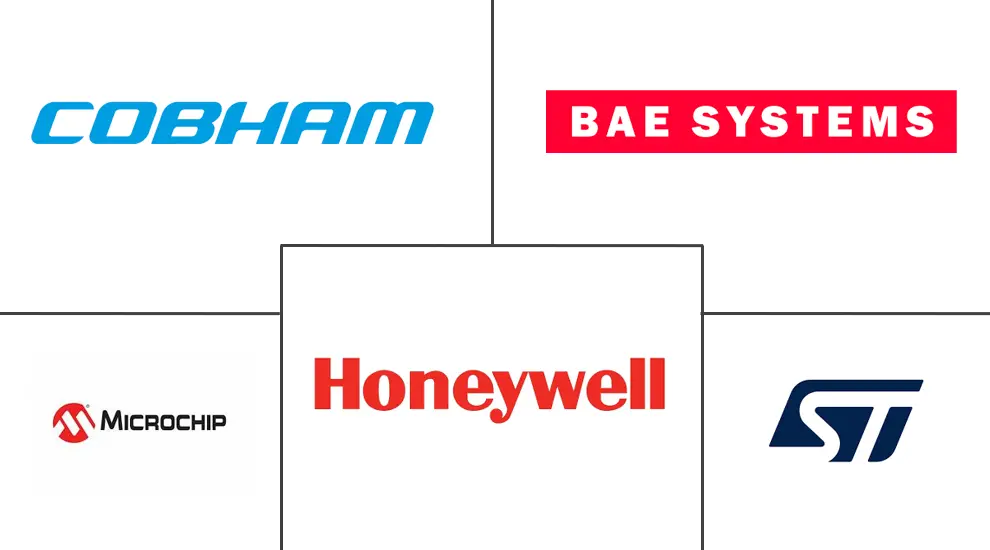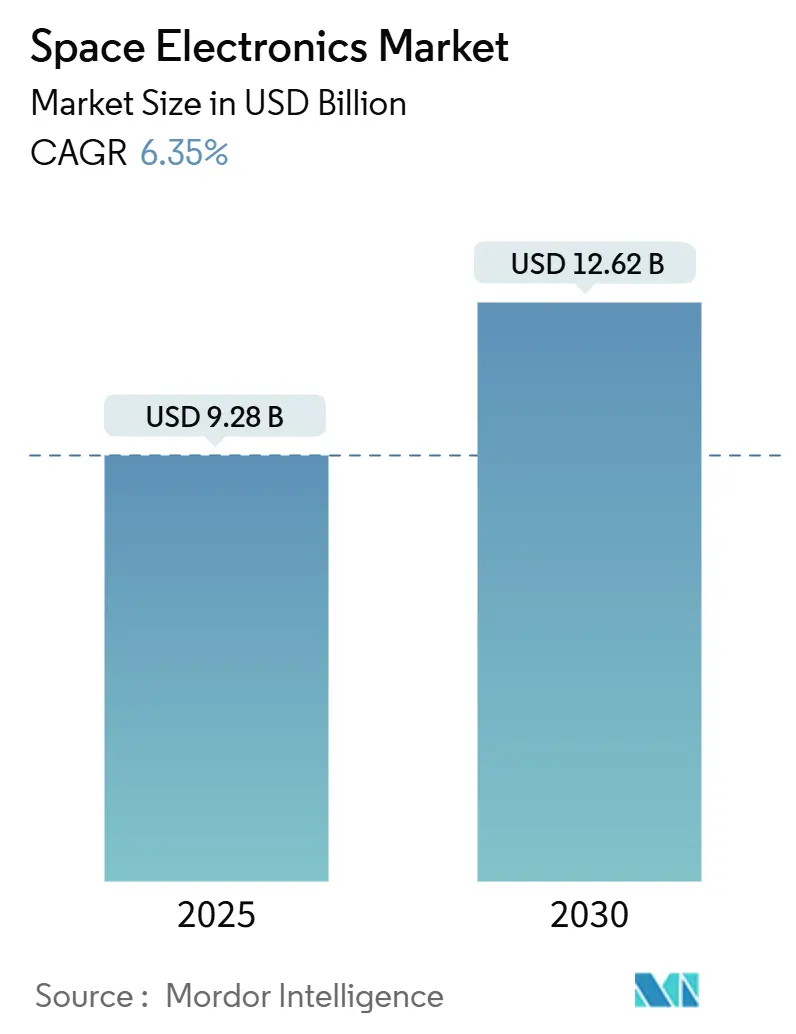
Space Electronics Market Analysis
The Space Electronics Market size is estimated at USD 9.28 billion in 2025, and is expected to reach USD 12.62 billion by 2030, at a CAGR of 6.35% during the forecast period (2025-2030).
The space electronics market is witnessing robust growth, propelled by increased satellite launches, escalating investments in the space sector, and a global push for enhanced communication and navigation. Notably, the space sector is witnessing a surge in investments, with a rising appetite for ventures like interplanetary exploration and potential space mining, further fueling the market expansion.
Moreover, the rising adoption of geospatial systems for heightened surveillance and quicker response times, coupled with advancements in microelectronics, is pivotal. These advancements enable the development of sophisticated space-based systems with advanced features while driving down associated research and development costs. As satellites find an expanding array of applications from surveillance and navigation to weather forecasting, bolstering network connectivity, and even integrating IoTs across commercial, governmental, and civil-military sectors, the market is presented with ample growth opportunities. The market faces hurdles in the form of high design and development costs for space-based electronics, alongside the complexity of creating realistic testing environments.
Space Electronics Market Trends
The Satellites Segment Holds Largest Shares in the Market
The satellite segment has surged to claim the largest market share, propelled by a rising number of satellite launches. With industries increasingly reliant on satellite data, this trend sees annual increments. Countries like the China, United States, Russia, the United Kingdom, Japan, India, Canada, and Germany are leading the charge in the satellite industry. Satellites have elevated geoinformation and space technologies to pivotal roles across various sectors, fueling annual launch growth.
Numerous countries are increasing their investments in satellite launches, mainly to bolster their surveillance capabilities. For example, in November 2023, North Korea unveiled a new rocket carrying a satellite, primarily for military reconnaissance. Similarly, in the same month, South Korea detailed plans to launch its inaugural indigenously developed military reconnaissance satellite atop a SpaceX Falcon 9 rocket. South Korea further outlined intentions to deploy four additional military spy satellites by 2025, with tests underway for more indigenously developed rockets.
Nano and microsatellites are gaining traction in the military domain as several armed forces seek smaller and less vulnerable options. The US Space Development Agency, formed in 2019, aims to have nearly 1,000 satellites in orbit by FY 2026. Its strategy emphasizes a shift toward smaller and cost-effective satellites in low earth orbit, as opposed to a few high-priced ones in GEO. These advancements are poised to propel the market's growth in the coming years.
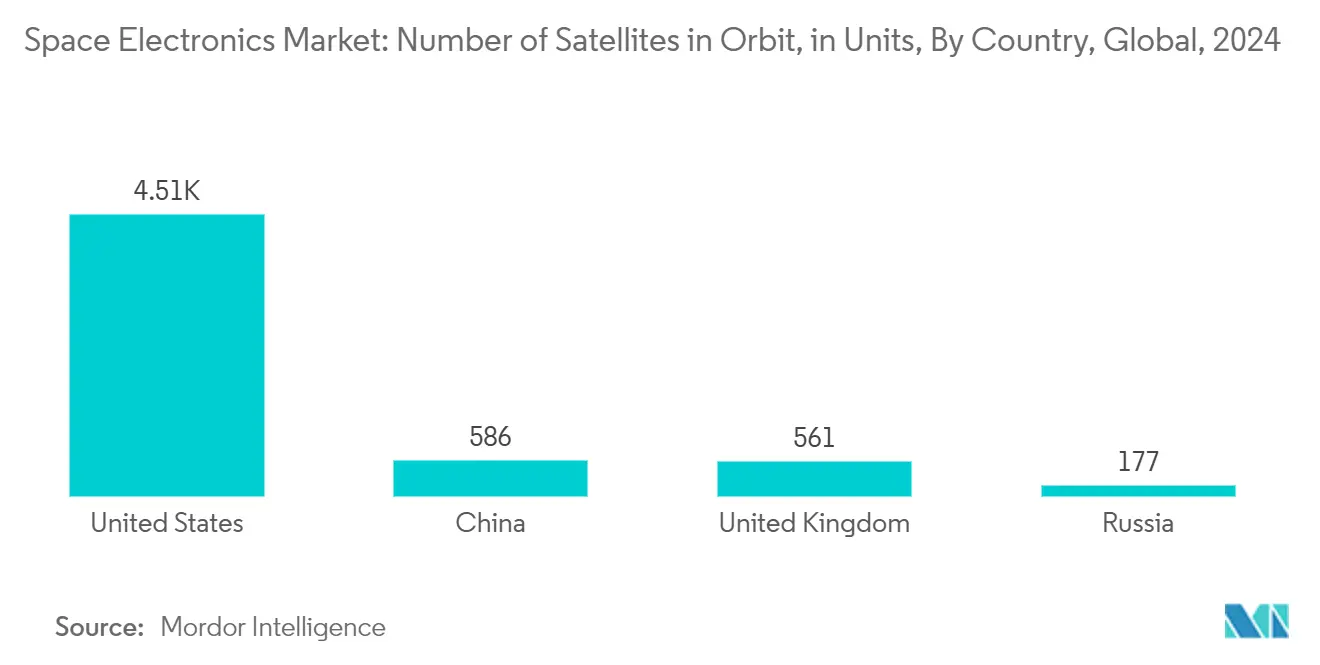
Asia-Pacific is Expected to Dominate the Market During the Forecast Period
The Chinese administration, recognizing the strategic importance of space-based infrastructure for the People's Liberation Army (PLA) in conducting operations beyond its borders, has consistently invested in space-related R&D. This investment aims to bolster military capabilities and address gaps in ISR. Additionally, China is set to witness the inaugural launch of its first commercial spacecraft site in 2024, marking a significant milestone. The nation is also expediting the networking and deployment of multiple satellite constellations.
India is asserting its presence in the competitive Asian space arena. With China eyeing a crewed moon mission by 2030, India's space endeavors are gaining momentum. In 2023, the Indian Space Research Organization (ISRO) achieved a notable feat, conducting seven missions. Meanwhile, Japan, a key regional player, set its records, launching satellites 67 times in 2023. Highlighting its commitment, in November 2023, Japan greenlit a USD 6.7 billion fund to bolster JAXA, its space agency. This financial injection aims to propel the Japanese space sector forward, focusing on advancements in rocket and satellite technologies.
These advancements across China, India, and Japan are not just technological milestones but also poised to significantly boost the demand for space electronics, setting the stage for robust market growth in the coming years.
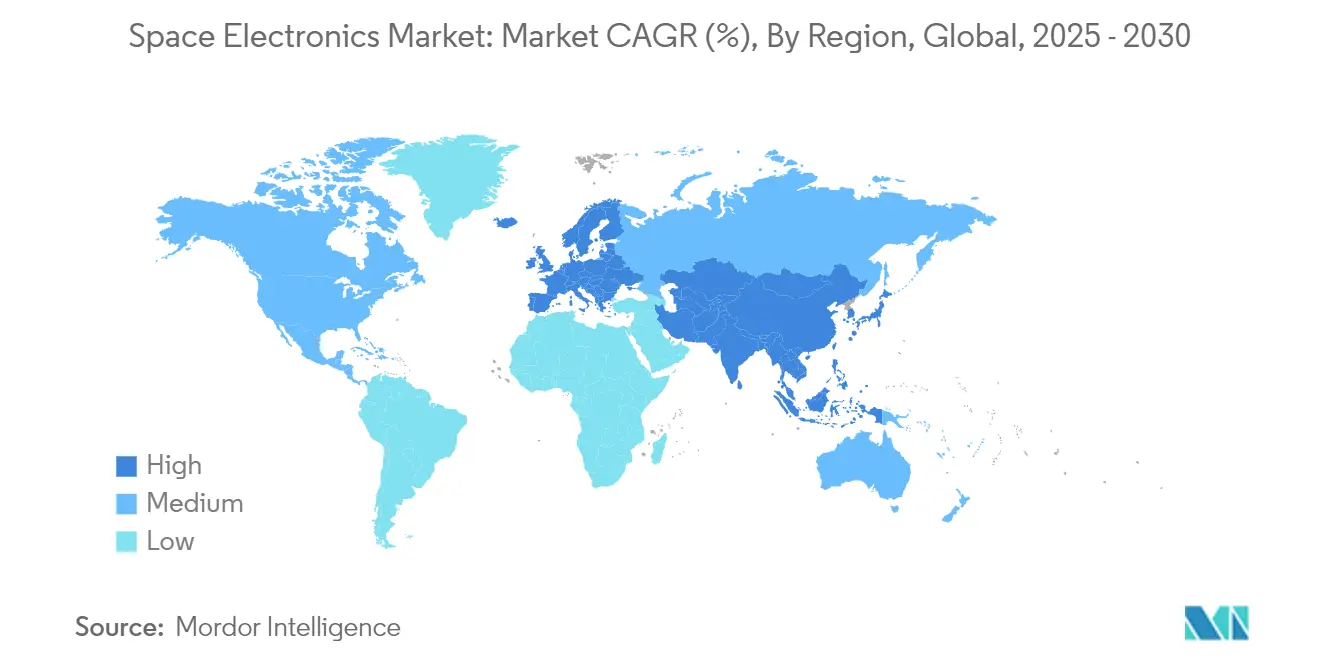
Space Electronics Industry Overview
The space electronics market is fragmented, with several players active in this sector. Prominent players include Cobham Limited, Microchip Technology Inc., BAE Systems plc, STMicroelectronics N.V., and Honeywell International Inc., with expertise in designing and manufacturing advanced electronic systems for space missions.
Leading players primarily rely on contracts to sustain their market dominance, complemented by the launch of innovative products featuring state-of-the-art technologies. Meanwhile, smaller specialized firms and startups are carving out their niches, concentrating on radiation-hardened electronics, satellite communication systems, and propulsion electronics. Key market drivers include technological progress, a rising appetite for satellites, and robust government backing for space exploration and national security.
Space Electronics Market Leaders
-
Cobham Limited
-
Microchip Technology Inc.
-
BAE Systems plc
-
Honeywell International Inc.
-
STMicroelectronics N.V.
- *Disclaimer: Major Players sorted in no particular order
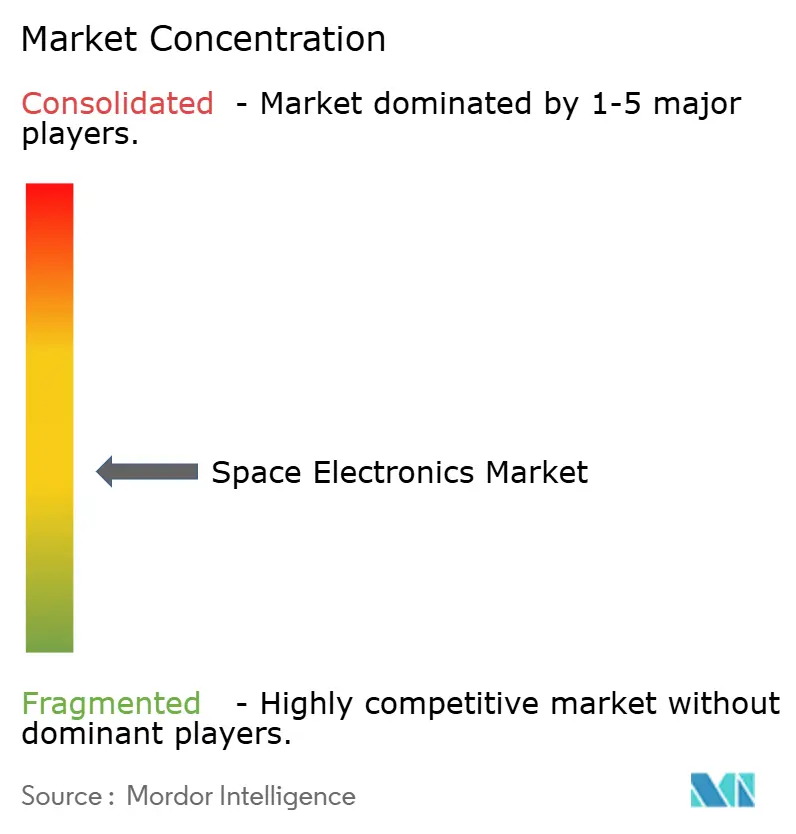
Space Electronics Market News
- September 2024: The Defence Research and Development Organisation (DRDO) has awarded Centum Electronics a USD 12.6 million contract for satellite systems. The contract includes the delivery of inter-satellite link and payload subsystems critical for satellite communication and data transmission. Centum Electronics will complete the project execution within 16 months.
- November 2023: The Office of Naval Research (ONR) awarded BAE Systems’ FAST Labs research and development organization a USD 5 million contract for the COALESCE (Common-architecture Amplifier for Low-cost, Efficient, SWaP-Constrained Environments) program. Under this contract, BAE Systems’ FAST Labs will focus on developing advanced Gallium Nitride (GaN)-based monolithic microwave integrated circuit (MMIC) and module electronics.
Space Electronics Industry Segmentation
Space electronics encompasses electronic components, systems, and equipment tailored for space missions. These technologies are engineered to endure the harsh conditions of space, such as radiation, vacuum, temperature fluctuations, and mechanical strains. The development of miniaturized components, radiation-hardened electronics, and automated systems with artificial intelligence capabilities improves the performance and reliability of electronic systems in space.
The space electronics market is segmented by platform, application, type, and geography. By platform, the market is segmented into satellites, launch vehicles, and deep space probes. By application, the market is segmented into communication, earth observation, navigation and surveillance, technology development and education, and other applications. By type, the market is segmented into radiation-hardened and radiation-tolerant. The report also covers the market sizes and forecasts for the space electronics market in major countries across different regions. For each segment, the market sizing and forecasts were made based on value (USD).
| Platform | Satellite | ||
| Launch Vehicles | |||
| Deep Space Probes | |||
| Application | Communication | ||
| Earth Observation | |||
| Navigation and Surveillance | |||
| Technology Development and Education | |||
| Other Applications | |||
| Type | Radiation-hardened | ||
| Radiation-tolerant | |||
| Geography | North America | United States | |
| Canada | |||
| Europe | United Kingdom | ||
| Germany | |||
| France | |||
| Russia | |||
| Rest of Europe | |||
| Asia-Pacific | India | ||
| China | |||
| Japan | |||
| South Korea | |||
| Rest of Asia-Pacific | |||
| Latin America | Brazil | ||
| Rest of Latin America | |||
| Middle East and Africa | United Arab Emirates | ||
| Saudi Arabia | |||
| Israel | |||
| Rest of Middle East and Africa | |||
Space Electronics Market Research FAQs
How big is the Space Electronics Market?
The Space Electronics Market size is expected to reach USD 9.28 billion in 2025 and grow at a CAGR of 6.35% to reach USD 12.62 billion by 2030.
What is the current Space Electronics Market size?
In 2025, the Space Electronics Market size is expected to reach USD 9.28 billion.
Who are the key players in Space Electronics Market?
Cobham Limited, Microchip Technology Inc., BAE Systems plc, Honeywell International Inc. and STMicroelectronics N.V. are the major companies operating in the Space Electronics Market.
Which is the fastest growing region in Space Electronics Market?
Asia Pacific is estimated to grow at the highest CAGR over the forecast period (2025-2030).
Which region has the biggest share in Space Electronics Market?
In 2025, the Asia Pacific accounts for the largest market share in Space Electronics Market.
What years does this Space Electronics Market cover, and what was the market size in 2024?
In 2024, the Space Electronics Market size was estimated at USD 8.69 billion. The report covers the Space Electronics Market historical market size for years: 2020, 2021, 2022, 2023 and 2024. The report also forecasts the Space Electronics Market size for years: 2025, 2026, 2027, 2028, 2029 and 2030.
Space Electronics Industry Report
Statistics for the 2025 Space Electronics market share, size and revenue growth rate, created by Mordor Intelligence™ Industry Reports. Space Electronics analysis includes a market forecast outlook for 2025 to 2030 and historical overview. Get a sample of this industry analysis as a free report PDF download.

